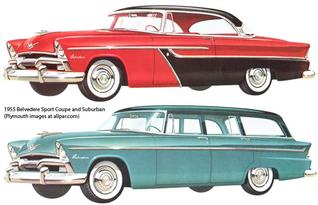 image source: www.allpar.com
image source: www.allpar.com From front end to taillights, along the chrome-trimmed two-tone (and even three-tone) side panels and up over the wraparound “New Horizon” windshield, the styling was swept back, raked like the wings of the F-86 Sabre, the jet fighter that recently had whipped so many MiG-15s in Korean War dogfights. The cars didn’t actually have wings, but it was easy to imagine they did. Both in terms of styling and surprisingly brisk performance, these innovative new models appeared to have absolutely nothing in common with their predecessors, cars that had been “new” just a year before. Compared to the ‘55s, the ’54s looked like frumpy old shoes, the kind my tottering (but oh so nice) fifth grade teacher used to wear. The ’55 models also sported nascent tail fins, a design cue that would grow to absurd heights in subsequent models.
My view of The Forward Look launch was from the inside of a Dodge-Plymouth dealership where my dad worked. The new cars were kept hidden in the shop ‘til announcement day. And when they were unveiled, people lined up in unprecedented numbers to buy them. Even the cheapest model of the least expensive Plymouth line -- base price around $1,700 -- looked great compared to the ‘54s. Our penny-pinching neighbor bought a black-and-white one with a three-speed manual shift on the column, no radio, black wall tires and a boring six cylinder engine instead of a V8; as I recall, even a heater was optional back then. But his car looked great, especially compared to our family's ride, a blocky 1950 Dodge Coronet my brothers and I called The Green Giant.
Ford and Chevrolet also turned out stylish new models in 1955, but theywere upstaged by The Forward Look, at least in the public eye. As a result, Plymouth production soared 52% in 1955. Dodge production grew a phenomenal 76%. Ford increased as well, up 25%. And Chevy made 49% more cars in 1955, although it must be noted that more Chevrolet- and Ford-badged models were sold that year than individual Chrysler models, which was true before and after 1955 until they finally were dethroned by the Japanese for the first time in June of 2008. The 1955 Fords and Chevys also were much better looking than their previous models (both have become classics) but were not as dramatically styled as Chrysler's cars.
The Forward Look positioned Chrysler Corporation for a strong run against its competitors, but grievous quality and design missteps, especially in 1957 and 1958 (driven by the need to change body styles every year and need to make more cars that they were accustomed to), would diminish Chrysler's fortunes in the years ahead, and by the early 1960s, The Forward Look had pretty much fizzled out. But while it lasted, it was a huge success – and great fun.
Takeaway: If you come up with a design innovation as set apart as the Forward Look, you can help drive sales with a compelling, memorable tagline – one that completely captures and extends your competitive advantage. Just don't lose sight of quality in your rush to meet demand.
For an entertaining trip down memory lane, check out this retro commercial for The Forward Look.

 RSS Feed
RSS Feed